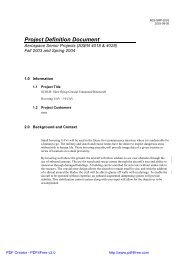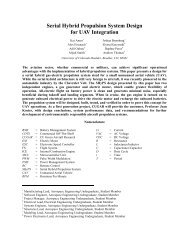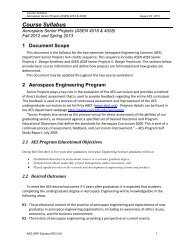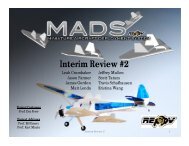PFR - Aerospace Engineering Sciences Senior Design Projects ...
PFR - Aerospace Engineering Sciences Senior Design Projects ...
PFR - Aerospace Engineering Sciences Senior Design Projects ...
Create successful ePaper yourself
Turn your PDF publications into a flip-book with our unique Google optimized e-Paper software.
Project Final Report – CUDBF April 30 th , 2009<br />
ASEN 4028: <strong>Aerospace</strong> <strong>Senior</strong> <strong>Projects</strong><br />
a battery voltage of 0.9V/cell on takeoff, there must be at least 22 batteries in order for the<br />
aircraft to make the 100ft takeoff distance.<br />
Next, the amount of battery cells required to make the four lap range with the full water bottle<br />
payload was calculated. The cruise power draw required for the full water bottle payload was<br />
assumed to be 350W. With an average lap time of 1:00 per lap, the battery must be able to run at<br />
cruise power for 4:00. Although the Elite 1500’s have 1500mah of capacity, the batteries cannot<br />
discharge this amount when discharged under high amp draw. Therefore, it was assumed that<br />
only 1000mah of actual usable power could be drawn from the battery pack before the power<br />
would drop off below a usable level. The rest would be dissipated as heat from the internal<br />
resistance of the battery cells. 1000mah of usable power means the batteries can be discharged at<br />
1 amp for an hour, or 15 amps for the required 4:00. While the Elite 1500’s are 1.2V batteries,<br />
the battery voltage drops while under such high amp draw. It was assumed that each battery<br />
would have an average voltage of 1.0V. In order to get 350W of power at a maximum average<br />
amp draw of 15 amps, the equation P=I*Vwas used to calculate the required battery pack<br />
voltage under load. The battery pack voltage must be at least 23.33V. Therefore, there must be at<br />
least 24 batteries in order to make the four lap range at full weight. From this analysis, the<br />
optimal battery pack size was determined to be 24 cells. With 24 cells, the battery pack weighs<br />
1.3lbs. A picture of the battery pack is shown in Figure 78.<br />
Figure 78: Battery Pack Overview<br />
The battery pack was designed like this in order to fit in the very nose of the aircraft. This allows<br />
the center of gravity to be moved as far forward as possible, increasing the aircraft static margin<br />
and overall aircraft stability.<br />
9.1.3 Electronic Speed Controller<br />
Electronic speed controllers are required for each motor in order to control the amount of power<br />
flowing from the battery pack to the motor. The speed controllers must be able to handle 33.6V<br />
and up to 40 amps each. The best speed controllers suggested for Neu Motors are Castle<br />
Creations Phoenix series. Within the Phoenix speed controller line up, three different speed<br />
controllers were considered.<br />
102
















